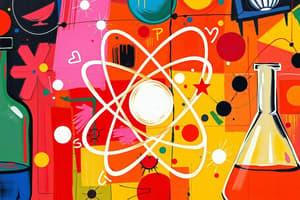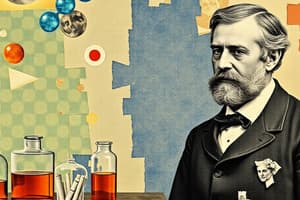Podcast
Questions and Answers
Who was Democritus?
Who was Democritus?
An ancient Greek thinker who believed that matter could be divided into smaller particles until a basic particle was reached, suggesting the existence of atoms.
What are atoms?
What are atoms?
The smallest particle of an element that retains both the chemical and physical properties of that element.
Who performed experiments to arrive at his Atomic Theory?
Who performed experiments to arrive at his Atomic Theory?
John Dalton
Which of the following are part of John Dalton's Atomic Theory? (Select all that apply)
Which of the following are part of John Dalton's Atomic Theory? (Select all that apply)
All of Dalton's theory is still true today.
All of Dalton's theory is still true today.
What are atoms made up of?
What are atoms made up of?
What is the actual mass of protons and neutrons?
What is the actual mass of protons and neutrons?
Chemists use ______ comparisons of the masses of atoms.
Chemists use ______ comparisons of the masses of atoms.
What is the unit of comparison for atomic mass?
What is the unit of comparison for atomic mass?
What does the atomic mass unit define?
What does the atomic mass unit define?
For all practical purposes, what is the mass of a single proton or neutron?
For all practical purposes, what is the mass of a single proton or neutron?
What is the symbol of an electron?
What is the symbol of an electron?
What is the relative electrical charge of an electron?
What is the relative electrical charge of an electron?
What is the approximate relative mass of an electron in amu?
What is the approximate relative mass of an electron in amu?
What is the actual mass of an electron?
What is the actual mass of an electron?
What is the symbol of a proton?
What is the symbol of a proton?
What is the relative electrical charge of a proton?
What is the relative electrical charge of a proton?
What is the approximate relative mass of a proton?
What is the approximate relative mass of a proton?
What is the actual mass of a proton?
What is the actual mass of a proton?
What is the symbol for a neutron?
What is the symbol for a neutron?
What is the relative electrical charge for a neutron?
What is the relative electrical charge for a neutron?
What is the approximate relative mass for a neutron?
What is the approximate relative mass for a neutron?
What is the actual mass of a neutron?
What is the actual mass of a neutron?
What is John Dalton's model of the atom?
What is John Dalton's model of the atom?
What shattered the idea of the invisible atom approximately 50 years after Dalton's death?
What shattered the idea of the invisible atom approximately 50 years after Dalton's death?
Who discovered the electron?
Who discovered the electron?
What model of the atom did Joseph J. Thomson propose?
What model of the atom did Joseph J. Thomson propose?
What does the plum pudding model describe?
What does the plum pudding model describe?
What led to two hypotheses after the discovery of the electron?
What led to two hypotheses after the discovery of the electron?
Who figured out the mass of the electron?
Who figured out the mass of the electron?
Who discovered the nucleus of an atom?
Who discovered the nucleus of an atom?
What did Rutherford conclude from his Gold Foil Experiment?
What did Rutherford conclude from his Gold Foil Experiment?
Who proposed a model of the atom wherein electrons orbit around the nucleus?
Who proposed a model of the atom wherein electrons orbit around the nucleus?
What is Bohr's model referred to as?
What is Bohr's model referred to as?
In Bohr's analogy, what do the rungs of a ladder represent?
In Bohr's analogy, what do the rungs of a ladder represent?
The amount of energy lost or gained by every electron is always the same.
The amount of energy lost or gained by every electron is always the same.
Unlike the rungs of a ladder, the energy levels in an atom are equally spaced.
Unlike the rungs of a ladder, the energy levels in an atom are equally spaced.
What is a quantum of energy?
What is a quantum of energy?
Who used the new quantum theory to describe the location and energy of an electron in a hydrogen atom?
Who used the new quantum theory to describe the location and energy of an electron in a hydrogen atom?
What is the quantum mechanical model?
What is the quantum mechanical model?
What do we use today to describe atomic structure?
What do we use today to describe atomic structure?
What is the atomic number?
What is the atomic number?
What is mass number?
What is mass number?
Since an atom is neutral, the number of protons equals the number of electrons.
Since an atom is neutral, the number of protons equals the number of electrons.
What determines what the atom is?
What determines what the atom is?
Atoms of the same element will always have the same number of ________ and ________.
Atoms of the same element will always have the same number of ________ and ________.
Atoms of the same element can have a different number of _____________, and therefore, a different _____________
Atoms of the same element can have a different number of _____________, and therefore, a different _____________
What are isotopes?
What are isotopes?
How do we distinguish atoms?
How do we distinguish atoms?
What does hyphen notation indicate?
What does hyphen notation indicate?
How do you determine the number of protons from an atomic notation?
How do you determine the number of protons from an atomic notation?
How do you determine the number of electrons from an atomic notation?
How do you determine the number of electrons from an atomic notation?
How do you determine the number of neutrons?
How do you determine the number of neutrons?
What do alpha particles consist of?
What do alpha particles consist of?
What do beta particles consist of?
What do beta particles consist of?
Why do alpha particles not travel very far?
Why do alpha particles not travel very far?
What can easily stop alpha particles?
What can easily stop alpha particles?
Why are alpha particles dangerous when ingested?
Why are alpha particles dangerous when ingested?
What distinguishes beta particles from alpha particles?
What distinguishes beta particles from alpha particles?
How are beta particles stopped?
How are beta particles stopped?
What are gamma particles?
What are gamma particles?
How can gamma particles be stopped?
How can gamma particles be stopped?
What does nuclear stability depend on?
What does nuclear stability depend on?
For elements of low atomic number, below about 20, this ratio is _________. This means the nuclei have equal numbers of __________.
For elements of low atomic number, below about 20, this ratio is _________. This means the nuclei have equal numbers of __________.
Above atomic number 20, the stable nuclei have more ____________ than ____________.
Above atomic number 20, the stable nuclei have more ____________ than ____________.
What is the band of stability?
What is the band of stability?
The stable ratio for lighter isotopes is represented as neutron/proton ratio=_____.
The stable ratio for lighter isotopes is represented as neutron/proton ratio=_____.
The stable ratio for heavier isotopes is represented as neutron/proton ratio=_____.
The stable ratio for heavier isotopes is represented as neutron/proton ratio=_____.
What occurs in region A?
What occurs in region A?
What occurs in region B?
What occurs in region B?
What occurs in region C?
What occurs in region C?
What is half-life?
What is half-life?
What does a longer half-life indicate?
What does a longer half-life indicate?
What happens in a chemical reaction?
What happens in a chemical reaction?
What happens in a nuclear reaction?
What happens in a nuclear reaction?
What is fusion?
What is fusion?
Fusion occurs on the ________ with _____________ combining to form ____________.
Fusion occurs on the ________ with _____________ combining to form ____________.
What is fission?
What is fission?
What determines the chemical properties of a substance?
What determines the chemical properties of a substance?
What determines the identity of a substance?
What determines the identity of a substance?
What provides nuclear stability?
What provides nuclear stability?
When are elements 1-20 stable?
When are elements 1-20 stable?
What do elements above 20 need to be stable?
What do elements above 20 need to be stable?
What is true about elements above atomic number 83?
What is true about elements above atomic number 83?
What is the strong nuclear force?
What is the strong nuclear force?
Flashcards are hidden until you start studying
Study Notes
Key Historical Figures and Concepts of Atoms
- Democritus: Ancient Greek philosopher suggesting matter can be divided into smaller particles called atoms.
- John Dalton: Developed Atomic Theory through experimental evidence.
- Atomic Theory Principles:
- Matter is composed of atoms.
- Identical atoms exist within the same element; different for different elements.
- Atoms are indivisible and cannot be created or destroyed.
- Atoms combine in whole-number ratios to form compounds.
- Atoms rearrange during chemical reactions.
Atomic Structure
- Atoms Composition: Composed of protons, neutrons, and electrons.
- Mass of Protons and Neutrons: Each has an actual mass of approximately 1.67 x 10^-24 grams.
- Atomic Mass Unit (amu): Defined as 1/12 the mass of a carbon atom with six protons and six neutrons, where 1 amu is taken to be the mass of a proton or neutron.
- Electron Characteristics:
- Symbol: e-
- Relative charge: 1-
- Approximate mass: 1/1840 amu, actual mass of 9.11 x 10^-28 grams.
Atomic Models and Discoveries
- Dalton's Model: Proposed the atom as invisible, the smallest unit of matter.
- Discovery of Subatomic Particles:
- Joseph J. Thomson: Discovered the electron and proposed the "plum pudding model" of the atom.
- Ernest Rutherford: Discovered the atomic nucleus via the "Gold Foil Experiment," concluding that most of an atom's mass is concentrated in a small nucleus.
- Niels Bohr: Proposed the "planetary model," where electrons orbit the nucleus with fixed energy levels.
- Erwin Schrödinger: Developed the quantum mechanical model, which predicts the probability of finding an electron in a given space around the nucleus.
Quantum Concepts
- Energy Levels: Non-equally spaced; higher levels correspond to greater distances from the nucleus.
- Quantum of Energy: The energy needed to move an electron to the next energy level.
Atomic Numbers and Isotopes
- Atomic Number: Indicates the number of protons; determines element identity.
- Mass Number: Sum of protons and neutrons; distinguishes isotopes, which are atoms of the same element with differing neutron counts.
- Chemical Symbols: Utilized to represent various atoms, e.g., ^1H where 1 denotes mass number and atomic number.
Radioactivity and Nuclear Stability
- Alpha Particles: Composed of 2 protons and 2 neutrons; low penetration ability, can be stopped by paper or skin.
- Beta Particles: Fast-moving electrons; more penetrating and can be stopped by aluminum foil.
- Gamma Rays: High-energy electromagnetic radiation; requires dense materials like lead or concrete for shielding.
- Nuclear Stability: Relies on the proton/neutron ratio; stable nuclei exhibit different behavior based on atomic number.
Nuclear Reactions vs Chemical Reactions
- Chemical Reactions: Involve electron interactions; do not affect the nucleus.
- Nuclear Reactions: Changes in the nucleus, leading to new elements via fusion (combining nuclei) or fission (nucleus decay).
- Half-life: Time taken for half of radioactive nuclei to decay; longer half-life indicates more stability.
Element Properties and Stability
- Protons: Determine substance identity.
- Neutrons: Provide stability in the nucleus.
- Reactant Requirements: Lighter elements are stable with equal protons/neutrons, while heavier elements need more neutrons for stability.
- Superfine Forces: Strong nuclear force holds the nucleus together, counteracting electrostatic repulsion among protons.
Studying That Suits You
Use AI to generate personalized quizzes and flashcards to suit your learning preferences.




